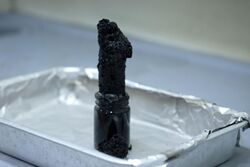Chemistry:Carbon snake
Carbon snake is a demonstration of the dehydration reaction of sugar by concentrated sulfuric acid. With concentrated sulfuric acid, granulated table sugar (sucrose) performs a degradation reaction which changes its form to a black solid-liquid mixture.[1] The carbon snake experiment can sometimes be misidentified as the black snake, "sugar snake", or "burning sugar" reaction, all of which involve baking soda rather than sulfuric acid.
Explanation
Concentrated sulfuric acid can perform a dehydration reaction with table sugar. After mixing, the color changes from white to brownish and eventually to black. The expansion of the mixture is the result of vaporization of water and CO2 inside the container. The gases inflate the mixture to form a snake-like shape, and give off a burned sugar smell.[1] The granularity of the sugar can greatly affect the reaction: powdered sugar reacts very quickly but sugar cubes take longer to react.[2]
When sucrose is dehydrated, heat is given out to the surroundings in an exothermic reaction, while graphite and liquid water are produced by the decomposition of the sugar:[3]
- C12H22O11 (s) + H2SO4 (aq) + 1/2 O2 (g) → 11 C (s) + CO2 (g) + 12 H2O (g) + SO2 (g)
As the acid dehydrates the sucrose, the water produced will dilute the sulfuric acid, giving out energy in the form of heat.
- C12H22O11 (s) → 12 C (s) + 11 H2O (l)
Alternative experiment
Paranitroaniline can be used instead of sugar, if the experiment is allowed to proceed under an obligatory fumehood.[4] With this method the reaction phase prior to the black snake's appearance is longer, but once complete, the black snake itself rises from the container very rapidly.[5] This reaction may cause an explosion if too much sulfuric acid is used.[6]
See also
- Elephant's toothpaste
- Black snake (firework)
- Chemical volcano
- Diet Coke and Mentos eruption
References
- ↑ 1.0 1.1 Shakhashiri, Bassam Z.; Shreiner, Rodney; Bell, Jerry A. (2011). "1.32 Dehydration of Sugar by Sulfuric Acid". Chemical Demonstrations a handbook for teachers of chemistry volume 1. University of Wisconsin Press. pp. 77-78. ISBN 978-0-299-08890-3. https://uwpress.wisc.edu/books/1740.htm.
- ↑ (in en) Don't Try This at Home - 3 - Sulfuric Acid and Sugar, https://www.youtube.com/watch?v=zg9wmU7Z-6s, retrieved 2022-01-31
- ↑ Roesky, Herbert W. (2007). "Experiment 6: Sugar coal by splitting off water from sugar with sulfuric acid". Spectacular Chemical Experiment. Wiley. pp. 17. ISBN 978-3-527-31865-0. https://www.wiley.com/en-us/Spectacular+Chemical+Experiments-p-9783527815241.
- ↑ Summerlin, Lee R.; Ealy, James L. (1988). "Experiment 77: Dehydration of p-Nitroaniline: Sanke and Puff". Chemical Demonstrations: A Sourcebook for Teachers Volume 1 (2nd ed.). American Chemical Society. pp. 171. ISBN 978-0-841-21481-1. https://eric.ed.gov/?id=ED286722.
- ↑ "Carbon Snake: demonstrating the dehydration power of concentrated sulfuric acid" (in en). 2013-06-06. https://communities.acs.org/t5/Educators-and-Students/Carbon-Snake-demonstrating-the-dehydration-power-of-concentrated/td-p/7732.
- ↑ (in en) Making a carbon snake with P-Nitroaniline, https://www.youtube.com/watch?v=YKHUnHDphTc, retrieved 2022-01-31
External links
- Dehydration of sucrose with sulfuric acid ChemEd X
- Sugar snake (Sugar and Baking soda) MEL science
- Sugar Snake: Sulfuric Acid and Sugar youtube.com
 |


